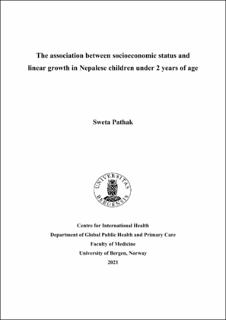| dc.description.abstract | The World Health Organization (WHO) and United Nations Children’s Fund (UNICEF) advocate the importance of the first 1,000 days (from conception to the 2nd birthday) for a child ́s optimum health, growth, and neurodevelopment. Most studies have investigated child linear growth and its determinants among children under 5 years of age. Furthermore, several studies have used single component measures of socioeconomic status (SES) such as assets, income, education, and occupation but few studies used multidimensional measures of SES. Therefore, we aimed to investigate the association of a range of measures of SES including multidimensional measures on linear growth among 600 children under 2 years of age from Bhaktapur, Nepal. Linear growth was assessed as length-for-age z-score using the WHO child growth standard. Length was measured at baseline (child aged 6-11 months) and follow-up (child aged 18-24 months). Measures of SES assessed were a WAMI (water and sanitation, assets, maternal education) index, combined or as individual components, father ́s education, and mother ́s or father ́s occupation. Linear regression models were employed to regress linear growth on the selected measures of SES. There were 49% female children. At baseline, the mean age (SD) was 8 (1.8) months, the mean length-for-age z-score (SD) was -1.8 (0.6), and the mean (SD) WAMI index was 0.65 (0.14). At baseline, only mother’s education was associated with length-for- age, whereas at follow-up, the WAMI index, parental education and occupation, and assets were associated with length-for-age when adjusted for mother’s age and type of family. The estimates did not change considerably when adjusted for mother’s height and child ́s sex in addition. In conclusion, different measures of SES were positively associated with linear growth among children under 2 years of age, where WAMI index, a multidimensional measure of SES, could be used as standardized approach to generalize SES of family across diverse population. | |
